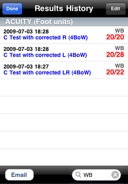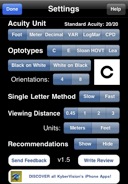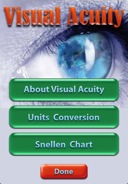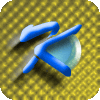Visual Acuity v1.5
Measure your Visual Acuity using a Modern Test!Visual Acuity is the first eye test on the iPhone platform developed by vision scientists and dedicated to the measurement of visual acuity, and that takes advantage of the Retina Display available in the iPhone 4. It is the perfect complementary tool for the optometrists and other vision care specialists. Visual Acuity uses a computerized and modern method (logMAR) which is becoming the preferred visual acuity test in many eye clinics, and is effectively replacing the imperfect Snellen chart. Two kinds of test are available: a 'single letter' test and an interactive 'chart' test. For the iPad version: check out "Visual Acuity XL" here.
You may also check out this HTML5 widget to find out the best visual acuity you can measure using an iOS device at a given viewing distance!




The single letter test follows an adaptive procedure that computes an acuity score similar to the tests performed in clinical environment (ETDRS). This test presents single letters at decreasing size until the user cannot reliably identify them. Two versions are available: a slower version that displays 5 letters for each presented size, and a faster version that displays only 1 letter per size.
The second test is an interactive logMAR chart. This test provides the fastest way to measure visual acuity in a precise and efficient way, and could not be easier to use:
1) set the viewing distance of the patient using the bottom slider (up to 8m),
2) select the range of the smallest letter sizes that can be easily seen by the patient by adjusting the vertical slider on the right or by pressing the + and - buttons for a finer control,
3) tap the smallest line the patient can fully read.
Several choices are available to customize both tests: optotypes (Landolt C, Tumbling E, Sloan, HOVT, Lea), acuity units (foot: 20/*, meter: 6/*, decimal, VAR, CPD or logMAR units), 4 or 8 orientations for the Tumbling E and Landolt C (8 improves the test reliability), black letter on white background or vice-versa. Acuity scores can be saved as function of the test condition (left, right or both eyes, optotypes, corrected or uncorrected). The acuity history also keeps notes about each measurement (eg, subject’s name) which can be used to retrieve the acuity history for a given patient. Tests history can be also emailed to yourself or others. The Tools section provides information and recommendations for the tests, a conversion tool between visual acuity units, as well as a standard Snellen chart for comparison purpose.




Why is logMAR better than Snellen? Because logMAR tests:
- use special fonts for the optotypes, in which all the lines are of equal thickness for all letters,
- present the same number of letters for each size,
- can be carried out at any distance allowing testing of very poor visual acuity,
- allow each presented letter to be scored individually to provide a more precise measurement,
- provide a logMAR score as a “real number” that can be used in calculations and statistics.
Contrarily to most other acuity charts available on the iPhone, Visual Acuity provides:
- eye charts that are randomly generated to prevent memory effects,
- support for viewing distance up to 8 meters (26 ft) in metric or imperial units,
- standard optotypes (letters or symbols) to test literate or illiterate people, and preschool children,
- support for the most common acuity units,
- and, most importantly, follows the logMAR design recommended by the National Eye Institute (NEI) and the International Council of Ophthalmology (ICO).
Version 1.5 (July 16, 2010):
Major update that provides the first Acuity Testing for Apple "Retina Display" (see our comprehensible blog entry on the controversy surrounding Apple's claims - http://www.kybervision.com/Blog/files/AppleRetinaDisplay.html - and why the iPhone 4 would be the perfect device for testing "Near Visual Acuity"):
- Support for iOS4,
- Support for the higher resolution of the iPhone 4's display,
- Addition of CPD (cycle per degree) units in Conversion Tool and lower acuity moved to 20/400 from 20/200,
- Addition of default viewing distance in Settings,
- Viewing distance can be precisely set by taping on the viewing distance value in all tests,
- Maximum measurable acuity indicated in red when changing the viewing distance (pixel size and viewing distance are the limiting factors when measuring visual acuity),
- Acuity of top line indicated in red when changing the vertical acuity slider in Chart Test,
- Addition of auditory feedback in Single Letter Test and decrease of the delay between optotype presentation,
- Single Letter Test supports now all optotypes and for distance up to 8 meters,
- Slow or fast version of the Single Letter Test can be selected in Settings,
- Recommendations provided when saving the acuity score can be disabled in the Settings,
- Addition of a warning when running in compatibility mode on the iPad (calibration made only for iPhone and iPod touch).
Version 1.4 (Oct 13, 2009):
- Improved email export of test history.
Version 1.3 (Sept 8, 2009):
- Addition of a Help section to each component.
- Addition of Sloan, HOTV and Lea interactive logMAR charts,
- Addition of a Search Bar in Test History section (applies only to Notes field),
- Improvement of single letter test with white letters on black background,
- Response controls in single letter test remain now presented all the time to speed up test,
- Redesign of Tools section (with a section dedicated to Snellen chart history, design & limitations).
Version 1.2 (July 3, 2009):
- Compatibility with iPhone OS 3.0,
- Addition of a conversion tool for acuity units in Help section,
- Addition of an interactive logMAR chart,
- Acuity results can now be reordered or deleted, and e-mailed as HTML table,
- Information about tested eye, eye correction etc. now asked after the test,
- Clearer Help section divided into Instructions, Conversion Tool, and Eye Charts subsections.
Version 1.1 (March 10, 2009):
- Minor cosmetic improvements,
- 'Stop' button now also used to stop test and provide option to save acuity score,
- Addition of VAR unit (Visual Acuity Rating),
- Addition of two new options in Settings section: choice for 4 or 8 orientations to improve reliability of the test, choice between black letter on white background or vice-versa,
- Better positioning of response buttons for those with a very low vision,
- Improved Help section,
- Addition of a standard Snellen chart in the Help section for comparison purpose (to be hold at arm length),
- Ability to provide some notes (can be used for example to specified user's name) for each test,
- Updated report with new settings in Tests History section (Notes and number of orientations and optotype aspect, for example '4BoW' to specify a test with 4 orientations and Black optotypes on White background).
Version 1.0 (February 21, 2009):
- First release on AppStore.




